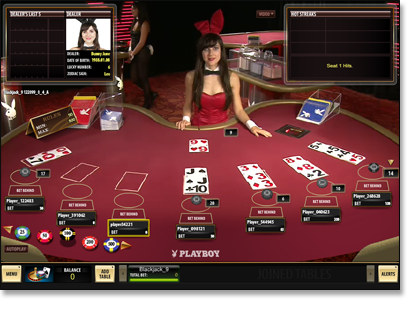Online blackjack games offer some of the best odds around, with most popular titles carrying a house edge of under 0.5 per cent. Not all games are quite the same, however, so we’ve gone and ranked the real money 21 titles at our top-ranked casino sites according to how little or how much they favour the dealer.
What is house edge in blackjack?
 House edge is a percentage which describes how much a player can expect to lose to the casino in the long run. For example: if the house edge on a casino game is 2.5 per cent, you can expect to lose about $2.50 out of every $100 you bet.
House edge is a percentage which describes how much a player can expect to lose to the casino in the long run. For example: if the house edge on a casino game is 2.5 per cent, you can expect to lose about $2.50 out of every $100 you bet.
While games like roulette and baccarat come with a fixed house edge for every type of wager, the casino advantage in blackjack depends on two things: the specific conditions of play, and the strategy employed by the player.
There are myriad different variants of online 21, and the removal or addition of a single rule can have a significant effect on a player’s expected returns. For example: when the dealer is forced to stand on a soft 17, the house edge is about 0.22 per cent lower than when the dealer hits a soft 17.
But these figures only really matter to players who use basic strategy – a system of play which ensures the house edge remains as low as possible. If you’re a newcomer to blackjack, or if you prefer to play by intuition, then it’s all but impossible to accurately calculate the casino advantage against your style of play. In all cases except card counting, the house edge for non-strategic play is much higher.
Casino edge for online blackjack games
While blackjack is better than most casino games when it comes to value for money, most tables at land-based gaming venues aren’t quite as accommodating as they used to be. Outside of the more liberal Vegas casinos, you will struggle to find a game on the main floor with a house edge under 0.50 per cent (with the exception of Spanish 21 and Australian pontoon).
That’s not the case when you play real money blackjack online, as most of the digital versions at our top-rated Internet casinos offer an expected return of well over 99.50 per cent with basic strategy. We’ve listed the most popular releases below, starting with the best-value titles at the top.
You will notice we’ve included two definitions of the house edge for each title listed. These figures correspond to the two key branches of basic strategy: total-dependent strategy (TDS), which only considers the point scores of player and dealer hands; and composition-dependent strategy (CDS), which also factors in the specific cards in play. The latter option can shave a little bit more off the house edge in certain games, especially those which use fewer than four decks.
Digital online blackjack games
| Game | Developer | House edge (TDS) | House edge (CDS) |
|---|---|---|---|
| Classic Blackjack Gold | Microgaming | 0.13% | 0.09% |
| Vegas Single Deck Blackjack | Microgaming | 0.35% | 0.31% |
| Vegas Strip Blackjack | Microgaming | 0.35% | 0.35% |
| Atlantic City Blackjack | Microgaming | 0.36% | 0.36% |
| Blackjack Single Deck | BetSoft | 0.38% | 0.34% |
| Spanish Blackjack | Microgaming | 0.38% | 0.38% |
| Vegas Downtown Blackjack | Microgaming | 0.39% | 0.38% |
| Blackjack Pro | Net Entertainment | 0.40% | 0.40% |
| Pontoon Pro | Net Entertainment | 0.41% | 0.41% |
| European Blackjack Gold | Microgaming | 0.42% | 0.40% |
| Premier Blackjack | Microgaming | 0.42% | 0.40% |
| Super 7 Blackjack | BetSoft | 0.46% | 0.46% |
| Single Deck Blackjack | Net Entertainment | 0.48% | 0.45% |
| 21 Burn | BetSoft | 0.54% | 0.54% |
| Double Exposure | Net Entertainment | 0.73% | 0.73% |
How blackjack rules affect expected returns
Below we’ve listed the most common rule variations for blackjack and their affect on a player’s expected returns. Positive values (e.g. +0.25%) signify a good rule for players, while negative ones (e.g. -0.25%) raise the casino’s advantage. We’ve calculated each rule’s effect in relation to Microgaming Atlantic City Blackjack, which comes with the following conditions:
- Eight decks
- Dealer peeks for blackjack
- Dealer stands on soft 17
- May double after splitting
- May double down on any two cards
- Resplit up to four hands
- Cannot resplit Aces
- Cannot hit split Aces
- Blackjack pays 3 to 2
- Late surrender
Good blackjack rules:
Single deck = +0.48%
Double down on any number of cards = +0.23%
Hit split Aces = +0.19%
Two decks = +0.19%
Early surrender against dealer 10 = +0.16%
Six-card Charlie = +0.16%
Four decks = +0.06%
Six decks = +0.02%
Bad blackjack rules:
Blackjack pays 1 to 1 = -2.27%
Blackjack pays 6 to 5 = -1.39%
Dealer hits soft 17 = -0.22%
Double down only on 10 or 11 = -0.18%
Cannot double after splitting = -0.14%
No peek for dealer blackjack (all bets lost) = -0.11%
No resplits = -0.10%
Double down only on nine, 10, or 11 = -0.09%
No surrender = -0.08%
Split up to three hands = -0.01%